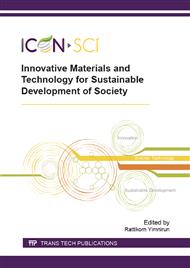p.129
p.133
p.139
p.143
p.147
p.151
p.155
p.159
p.163
Effects of the Sintering Temperature on Structural and Bioactivity in BaFe12O19-P2O5-CaO-Na2O Bioactive Glass Ceramic
Abstract:
In this research, the effects of sintering temperatures on structural and bioactivity in BaFe12O19 (BF) /P2O5-CaO-Na2O bioactive glass ceramics were investigated. The BF/P2O5-CaO-Na2O bioactive glass ceramics were fabricated under various sintering temperatures in a range of 550-700 oC. X-ray diffraction (XRD) technique and the scanning electron microscopy (SEM) are used to characterize phase and microstructure. The studied samples were evaluated for mechanical properties by hardness testing. Moreover, the bioactivities of studied samples were studied by using simulated body fluid (SBF) in vitro. It was found that, the sintering temperatures are the most influential parameter on microstructure and mechanical properties of the bioactive glass ceramics. The highest density of studied ceramics was found in the sample sintered at 700 oC. The microstructural properties of the studies samples were investigated and the results were then correlated with the characteristics of sintering temperature as well as the microstructure of the bioactive glass ceramic. Moreover, the covering of bone-like apatite layer on the surface sample after a 7 day immersion in SBF suggested that the BF/P2O5-CaO-Na2O glass ceramics have acceptable bioactivities.
Info:
Periodical:
Pages:
147-150
Citation:
Online since:
October 2015
Price:
Сopyright:
© 2015 Trans Tech Publications Ltd. All Rights Reserved
Share:
Citation:


